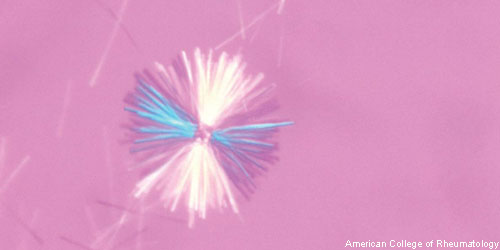 With guidelines from the ACR and the European League Against Rheumatism (EULAR) recommending gout patients keep their uric acid levels below 6.0 mg/dL, the Gout & Uric Acid Education Society (GUAES) is emphasizing 6 as a target for patients, says N. Lawrence Edwards, MD, MACP, MACR, chair and CEO of GUAES. Dubbed the Go for Six campaign, the society kicked off the education initiative on May 22, 2015, with Gout Awareness Day.1,2
With guidelines from the ACR and the European League Against Rheumatism (EULAR) recommending gout patients keep their uric acid levels below 6.0 mg/dL, the Gout & Uric Acid Education Society (GUAES) is emphasizing 6 as a target for patients, says N. Lawrence Edwards, MD, MACP, MACR, chair and CEO of GUAES. Dubbed the Go for Six campaign, the society kicked off the education initiative on May 22, 2015, with Gout Awareness Day.1,2
Dr. Edwards, who co-authored the ACR’s most current guideline, 2012 Guidelines for the Management of Gout, and is a professor of medicine in and vice chair of the Department of Medicine, University of Florida, Gainesville, Fla., says both organizations support a treat-to-target approach and chose 6.0 mg/dL as the target number because multiple clinical trials demonstrated that when a gout patient suppresses their uric acid level to 6.0 mg/dL or below, their main symptoms may decrease in frequency over the first couple of years of treatment with first-line medications until they completely disappear. And if tophi exist, they may also disappear in time. By comparison, when a patient’s uric acid levels remain above 7.0, their disease continues to worsen over time.
Embrace Treatment
So how do physicians advise patients on how to keep their uric acid levels below 6.0?
Some patients think they can treat gout with diet alone, but Dr. Edwards says that is rarely the case. Although he does recommend a Mediterranean diet, with its emphasis on fresh fruits and fish, Dr. Edwards says, “if [patients] know that certain foods trigger their gout flares, such as red meat, shellfish or beer, then they should avoid them. But doing that alone won’t eliminate gout symptoms.”
Dr. Edwards says patients can become compliant by taking a daily uric acid-lowering therapy, primarily allopurinol or febuxostat. In addition, patients should have their uric acid levels checked every one to two months as they adjust to the medication. After a patient’s uric acid level dips below 6.0, they can have their levels checked less frequently—every six to 12 months—to ensure it remains in range.
Throughout a patient’s lifetime, it’s important to check uric acid levels because alterations in an individual’s environment and body can cause uric acid levels to creep upward. For example, certain medications that treat comorbid conditions of gout—such as diuretics for hypertension, low-dose aspirin for coronary artery disease and lipid-lowering agents for high cholesterol—can increase uric acid levels. If a patient loses a significant amount of weight, they may be able to decrease their dosage of a uric acid-lowering therapy.
Dr. Edwards also advises physicians to point patients to GUAES’ website, GoutEducation.org, for more gout information and advice. Eleven years ago, he and H. Ralph Schumacher Jr., MD, a rheumatologist, originally started the website as an educational resource for patients.
“Physicians should also be aware that four years ago, GUAES’ website expanded to contain a link to ACR’s Guidelines for the Management of Gout. It details the clinical guidelines and research that support keeping uric acid levels to below 6.0,” he says. It also contains information on new research.
In the two years since the campaign launched, it has reached 374 million people online and through other media outreach, social media and medical conferences. In addition, traffic to GoutEducation.org has increased significantly (29%) since the campaign began, reinforcing that more gout patients are turning to GUAES for information and resources. With these statistics in mind, Dr. Edwards views the Go for Six campaign as a success.
Karen Appold is a medical writer in Pennsylvania.
References
- Khanna D, Fitzgerald JD, Khanna PP, et al. 2012 American College of Rheumatology guidelines for management of gout. Part 1: Systematic nonpharmacologic and pharmacologic therapeutic approaches to hyperuricemia. Arthritis Care Res (Hoboken). 2012 Oct;64(10):1431–1446.
- Khanna D, Khanna PP, Fitzgerald JD, et al. 2012 American College of Rheumatology guidelines for management of gout. Part 2: Therapy and antiinflammatory prophylaxis of acute gouty arthritis. Arthritis Care Res (Hoboken). 2012 Oct;64(10):1447–1461.


